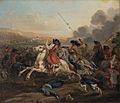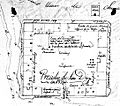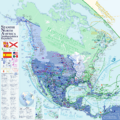Spanish colonization of the Americas facts for kids

The Spanish colonization of the Americas began with the arrival in America of Christopher Columbus (Cristóbal Colón) in 1492. This was the first part of the European colonization of the Americas.
The Spanish expanded their territories in America over four centuries until it included Central America, most of South America, Mexico, the South of what today is Southern United States, the Western part of what today is Central United States, the Southwestern part of what today is British Columbia in Canada, and even reaching Alaska. At the beginning of the nineteenth century, the Spanish possessions in America began a series of independence movements, which lead to the complete separation from Spain by the mid 1820's of Mexico, and the colonies in Central and South American. The remaining Spanish colonies, Cuba and Puerto Rico, were lost in 1898 as a consequence of the Spanish-American War.
Images for kids
-
The Discovery Of America (Johann Moritz Rugendas).
-
Depiction of Pizarro seizing the Inca emperor Atahualpa. John Everett Millais 1845.
-
Bust of Álvar Núñez Cabeza de Vaca, who wrote epic account of years of wandering in the North American south and southwest.
-
National Palace, Mexico City, built by Hernán Cortés in the Aztec central zone of palaces and temples.
-
A mounted Mapuche carrying off a Spanish woman. Johann Moritz Rugendas
-
Nicolás de Ovando, sent by the crown to assert royal control
-
Detail of a gallery of portraits of sovereigns in Peru, showing continuity from Inca emperors to Spanish monarchs. Published in 1744 by Jorge Juan and Antonio de Ulloa in Relación del Viaje a la América Meridional
-
View of the Plaza Mayor of Mexico City and the viceroy's palace, by Cristóbal de Villalpando, 1695
-
Members of the Real Audiencia (Royal Audience) of Lima, the presidente, alcaldes de corte, fiscal and alguacil mayor. (Nueva Crónica y Buen Gobierno, p. 488)
-
Cabildo in the city of Salta (Argentina)
-
Church of la Companía Society of Jesus in Cuzco, Peru
-
Luis de Mena, Virgin of Guadalupe and racial hierarchy, 1750. Museo de América, Madrid.
-
Tribute from one region of the Aztec Empire as shown in Codex Mendoza
-
Depiction of the patio process at the Hacienda Nueva de Fresnillo, Zacatecas, Pietro Gualdi, 1846.
See also
 In Spanish: Colonización española de América para niños
In Spanish: Colonización española de América para niños

































